Mexico: Violence, Corruption and Inequality — AMLO to the Rescue?
By Michael Roberts
July 30, 2018 "Information Clearing House" - The victory in Mexico’s presidential election of Andrés Manuel López Obrador (AMLO), under the rubric of his relatively new ‘progressive’ Morena party, is both unsurprising and surprising. It’s unsurprising because AMLO had a huge and increasing lead in the opinion polls leading up to polling day. And Mexico’s 88 million voters (out of 127 million people) have now given him the biggest win in post-war election history, with over 53 per cent of the vote. The candidates of the establishment parties were way behind. For the first time, the parties of the elite and the status quo were split over who should be their standard bearer. And the sheer anger and frustration at the state of Mexico’s economy and daily life for average citizens has swept AMLO into office.
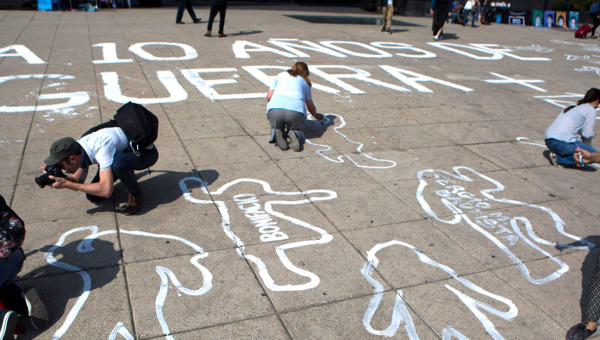 But
the result is also surprising because the
ruling classes’ immense power to ‘fix’ the
election (as they have done in the previous
ones), or to find a way to stop AMLO
politically has failed. Of course, the
Mexican courts may attempt to overturn the
result on alleged ‘irregularities’ but such
is the size of AMLO’s victory, that such a
trick will probably not succeed. AMLO’s
party Morena has also gained a majority in
the Mexican Congress and has won at least
five of nine gubernatorial races, with the
winners including Mexico City’s first
elected female mayor, Claudia Sheinbaum. But
Morena is in alliance with a small extreme
Christian fundamentalist party which may
moderate what the new administration will
do, particularly in social and ‘family’
matters.
But
the result is also surprising because the
ruling classes’ immense power to ‘fix’ the
election (as they have done in the previous
ones), or to find a way to stop AMLO
politically has failed. Of course, the
Mexican courts may attempt to overturn the
result on alleged ‘irregularities’ but such
is the size of AMLO’s victory, that such a
trick will probably not succeed. AMLO’s
party Morena has also gained a majority in
the Mexican Congress and has won at least
five of nine gubernatorial races, with the
winners including Mexico City’s first
elected female mayor, Claudia Sheinbaum. But
Morena is in alliance with a small extreme
Christian fundamentalist party which may
moderate what the new administration will
do, particularly in social and ‘family’
matters.
|
Are You Tired Of The Lies And Non-Stop Propaganda? |
Three Key Issues
AMLO has won because he campaigned on
three key issues that enrage and engage
Mexicans: rising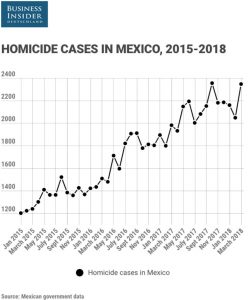 pervasive and daily violence across the
country; endemic corruption among
politicians and officials; and high and
rising inequality between rich and poor.
pervasive and daily violence across the
country; endemic corruption among
politicians and officials; and high and
rising inequality between rich and poor.
On average, someone was killed in Mexico every 15 minutes during the month of May, putting the country on track to surpass last year’s grim milestone of 29,168 killings.
Political killings have also shot up,
with 130 politicians, including 48
candidates for office, murdered since the
beginning of the electoral cycle in
September, according to political
consultancy Etellekt.
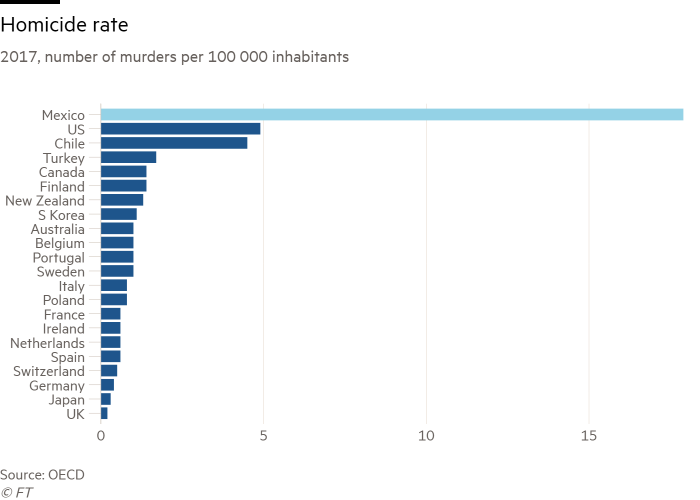
Behind this violence lies the battle of the
drug cartels, organized crime and general
criminality which is often settled by
assassination. The police are either lacking
in personnel or backing from the government;
or both are in league with the criminals.
Corruption is integrally linked to the
massive profits made from drug trafficking
and production, and other criminal activity.
Politicians of the establishment parties
were up to their neck in this. Mexico’s
global corruption ranking has never been
higher.
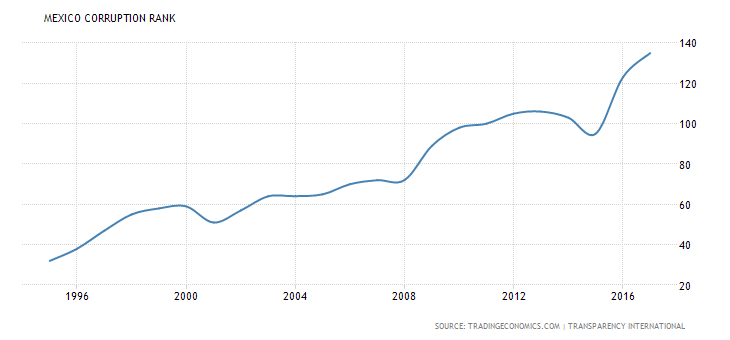
The country has been rocked by a succession
of eye-watering corruption scandals,
including that of Javier Duarte, a PRI
governor who went awol in a government
helicopter in 2016 after being accused of
corruption and whose wife recently turned up
living in luxurious exile in one of London’s
poshest boroughs. The government of
President Enrique Peña Nieto was riddled
from practically the moment he took office.
His
wife purchased a bespoke home from a
government contractor on favourable terms.
Then there was the cover-up of the horrific
disappearance of 43 teachers’ college
students, the
use of sophisticated spyware purchased
by the government to monitor journalists and
human rights lawyers, while top officials
embezzled public funds to pay for party
electoral campaigns.
AMLO has pledged to end corruption – but how this is to be done remains unclear. AMLO says he will allow a recall of officials in office after two years (including the presidency) and he will sell the presidential plane and only live in modest premises.
AMLO says he will stand up for the poor
(over 50 million Mexicans are designated as
such) first over the rich. And that is the
third issue that has led to his election
victory. Mexico is one of the most unequal
societies in the world in the 21st century –
surpassed only by post-apartheid South
Africa. Recently the U.S. Brookings
Institution adjusted the standard measure of
inequality in a country, the Gini
coefficient. The nearer the Gini is to 1,
the higher the level of inequality. On its
new estimates, Mexico’s Gini coefficient for
2014 rises from an already high 0.49 to a
mega 0.69, close to that of South Africa,
the world’s most unequal country.
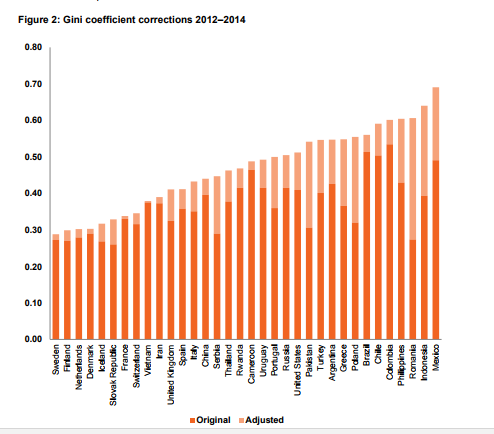
Stagnant Economy
Behind the shocking story of violence, corruption and inequality lies the stagnant state of the Mexican economy. It’s the 15th largest in the world as measured by GDP and the second largest in Latin America. It is sufficiently advanced to be included in the top 30 OECD economies. And yet it is in a sorry state.
The inequality is not just between rich
and poor but also in the uneven development
of the economy under capitalism. Cumulative
economic growth in the best-performing
Mexican states reached 32% between 2007 and
2016, about double the average for Latin
America. But this is about four times the
rate of growth in the low-performing states.
Per capita output shows the same diverging
path.
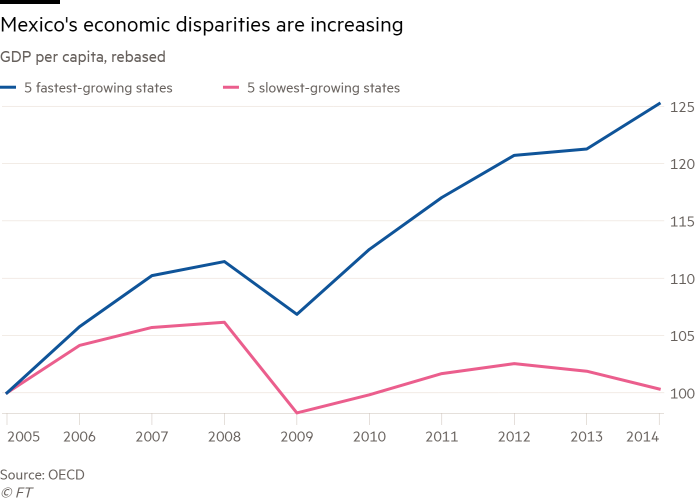
In Oaxaca and Chiapas, for example, about
70% of the population is in poverty and
23-28% in extreme poverty, according to data
from the National Council for the evaluation
of socio-political development (CONEVAL).
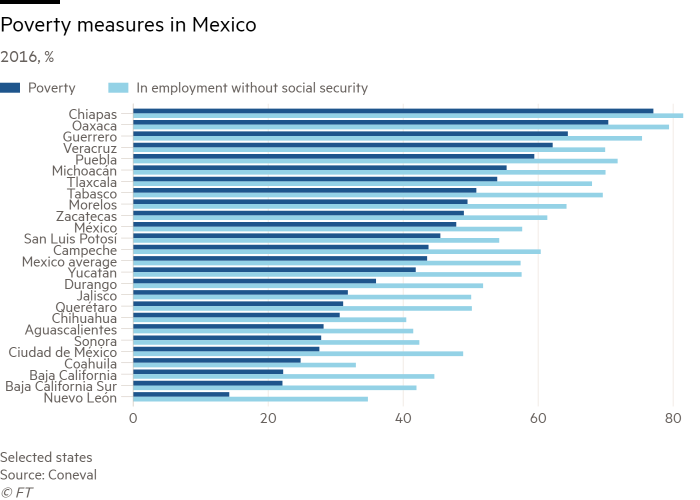
Contrary to the views of mainstream
economics, the 1994 NAFTA trade deal with
the U.S. and Canada has not taken the
Mexican economy forward. Indeed, whereas the
Mexican economy more than doubled to reach
16% of the U.S. output in the 30 years to
the mid-1980s, it has declined to 12% since
then.
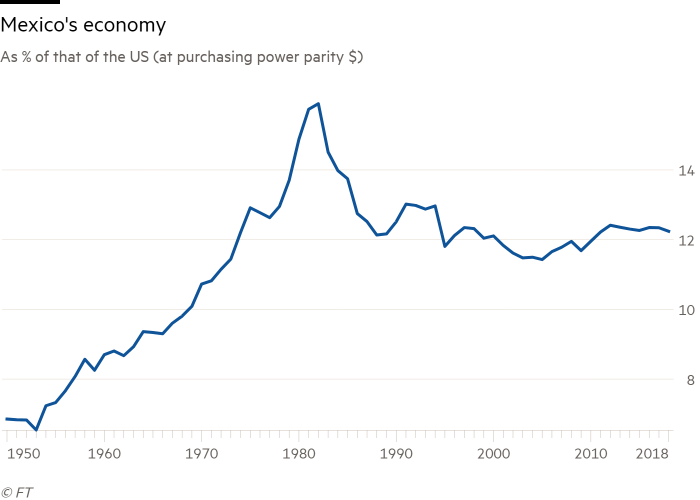
Mexico’s output per hour worked relative to
that of the U.S. is near its lowest level
since 1950.
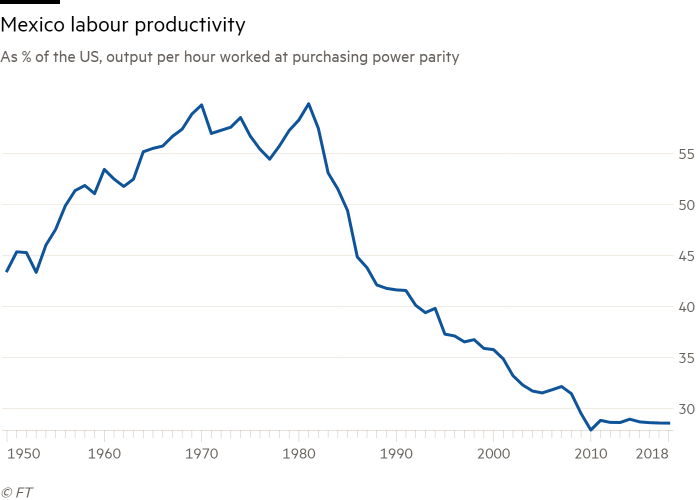
NAFTA, far from boosting Mexico’s economic
performance, increased its dependence on
U.S. trade and investment, locked in the
neoliberal measures of the 1980s and
increased the disparities between the
faster-growing U.S. border areas with their
special economic zones and the poor southern
rural regions. And now U.S. President Trump
is insisting on renegotiating to make it
even more favourable to the USA!
Moreover,
as the excellent report by the CEPR argues,
If NAFTA had been successful in restoring
Mexico’s pre-1980 growth rate, Mexico today
would be a high income country, with income
per person significantly higher than that of
Portugal or Greece. It is unlikely that
immigration reform would have become a major
political issue in the United States, since
relatively few Mexicans would seek to cross
the border.
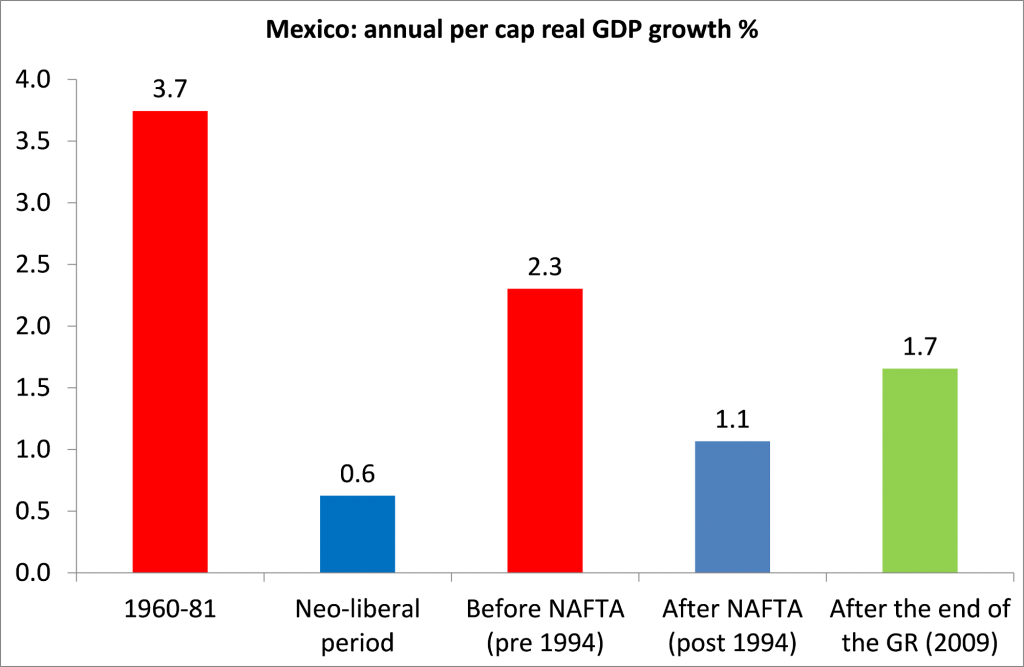
Mexico’s poverty rate of 55.1% in 2014 was
higher than the poverty rate of 1994. As a
result, there were about 20.5 million more
Mexicans living below the poverty line as of
2014 (the latest data available) than in
1994. Real wages have made little progress
since 1994. There was a fall in real wages
of 21.2% from 1994–96, associated with the
peso crisis and recession. Wages did not
recover to their pre-crisis (1994) level
until 2006, 11 years later. By 2014, they
were only 4.1% above the 1994 level, and
barely above their level of 1980. The
minimum wage, adjusted for inflation, fared
even worse. From 1994 to 2015, it fell by
19.3%.
As a result of low
profitability and investment, along with the
impact of the NAFTA deal, the Mexican
economy has basically stagnated. The reason
lies with the failure of Mexico’s capitalist
sector. Yes, the ‘neoliberal period’ since
the early 1980s, presided over by successive
establishment, pro-business Mexican
governments, did stem the fall in the
profitability of Mexican capital to some
extent, but it failed to turn profitability
up, as was achieved in most other capitalist
economies.
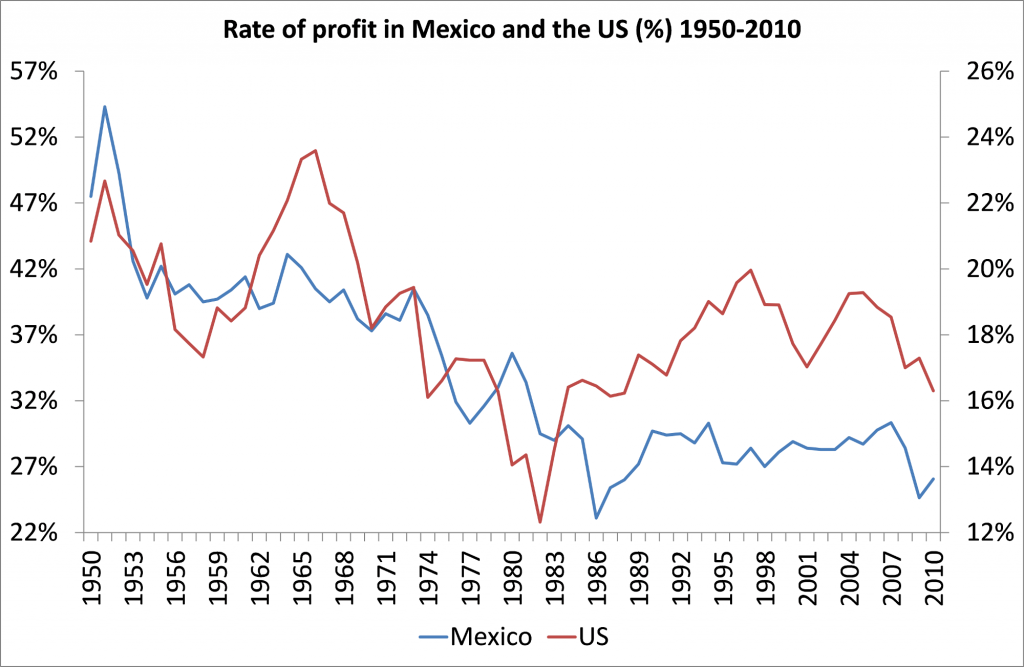
Slow economic growth in the post global
crash period has led to a crisis in public
finances as the state had to pick up the
bill from the private sector’s failure.
Between 2008 and 2018, public debt grew from
21% of GDP in 2008 to 45.4% of GDP in 2018.
Servicing this debt now absorbs 20% more
government revenue than that allotted for
health, education and poverty reduction in
the federal budget. This is the burden that
AMLO will inherit.
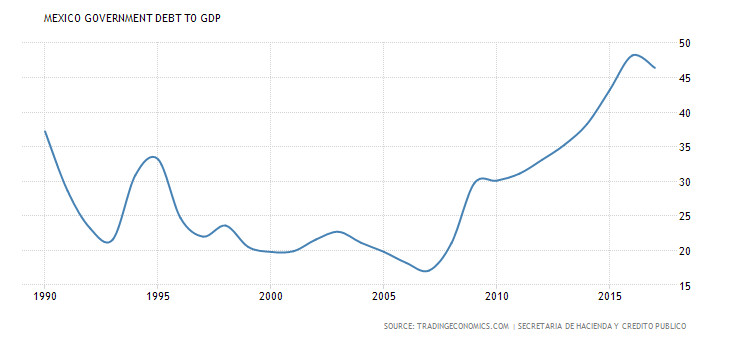
The OECD, the main promoter of neoliberal measures in Mexico, claims that “growth is set to pick up, underpinned by private consumption and exports.” But even the OECD reckons “uncertainty (with Trump) will continue to restrain private investment”. However, “private investment could accelerate if the NAFTA negotiations end favourably.” And it continues to demand “structural reforms” (ie neoliberal measures of government spending cuts and privatizations) “to strengthen the rule of law and improve institutional quality.” (!).
Despite the OECD’s optimism, capitalist sector investment has stagnated or fallen since the end of the Great Recession.
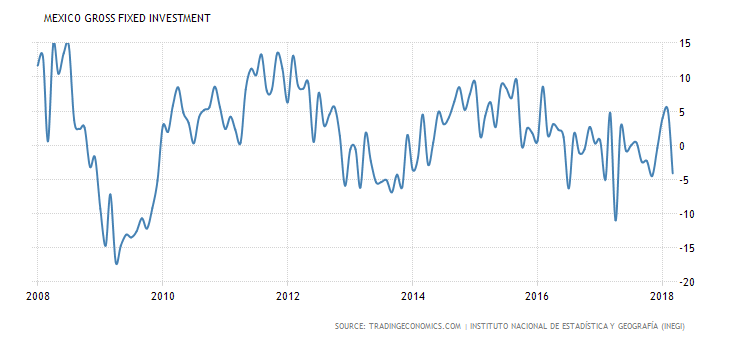
And that is because the profitability of
Mexican capital has not recovered since the
Great Recession, at least according to the
net rate of return on capital data offered
by AMECO. Indeed, profitability is still
some 18% below the level of 2007 and 28%
below the 1997 ‘neoliberal’ peak.
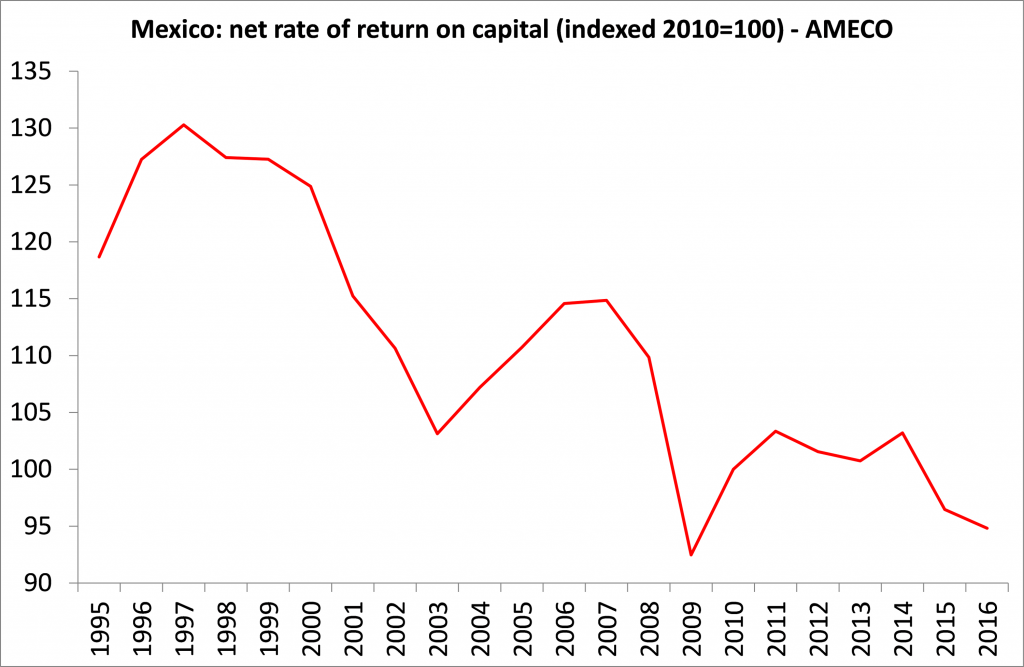
AMLO’s programme is fundamentally Keynesian, using public investment to ‘prime the pump’ of private investment and claiming that money saved from reduced corruption will deliver the funding. But he is unwilling to reverse the part-privatization of PEMEX, the state oil company or end the proposed new ‘nightmare’ Mexico City airport – only to consider ‘reviewing the contracts’. But how can AMLO turn things round on corruption, inequality and violence without control of the banks (mainly foreign), renationalization of PEMEX and taking over the major multi-national operations within Mexico?
Donald Trump congratulated AMLO on his win. But Mexico’s northern neighbour is now being run by a nationalist, imperialist crazy bent on launching a trade war with all and sundry. Mexico is right in the front line of this whirlwind, with a capitalist economy that is struggling amid poverty, corruption and violence. Nevertheless, with a huge and young population, oil and gas resources and modern industry in parts, Mexico is in a much better position to succeed than Venezuela and Cuba was. AMLO does not take over the presidency for another five months (December). He has major challenges ahead. •
This article first published on thenextrecession.wordpress.com website.
The views expressed in this article are solely those of the author and do not necessarily reflect the opinions of Information Clearing House.
======
Join the Discussion
It is not necessary for ICH readers to register before placing a comment. We ask that you treat others with respect. Take a moment to read the following - Comment Policy - What Or Who is Information Clearing House and Purpose and Intent of this website: It is unacceptable to slander, smear or engage in personal attacks on authors of articles posted on ICH. Those engaging in that behavior will be banned from the comment section.

